An interview with Cell Worlds
Posted by the Node, on 14 July 2022
Cell Worlds is an innovative project aiming to bring microscopy images out of the lab to the attention of the general public. It has received a fantastic reaction in the scientific community, and more importantly among their target audience. Cell Worlds takes the viewer on a journey into the microscopic world, while sharing information about the biology behind the beautiful images. To learn more about the background of the project we caught up with the founders of the Cell Worlds, Terence Saulnier and Renaud Pourpre, while on our sister site, FocalPlane, we focus on the microscopists that acquired the image used in Cell Worlds.
In addition to the text version of our interview, we have embedded the full audio version below. We did not originally intend to release the recording, but we think that this format gives an even better insight into the enthusiasm and passion of Renaud and Terence. We apologise for some issues with the sound quality and please note that there are a couple of swear words in the recording.
Can you tell us about your background and how you got started with science communication?
Renaud – I have been interested in science since high school and have a PhD in microbiology and epigenetics. When I began my PhD, I became aware of the need to tell our stories and get our messages to people outside of science; there are so many interesting stories! I started doing science communication by myself, alongside my PhD; making some videos and some events. But after I completed my PhD in 2019, I decided that I wanted to build a career in science communication and dedicate myself to working in that space. I started by creating a podcast called ‘The lonely pipette’, with a researcher, ….. Through this, I started to work directly with scientists to help them promote their stories and their research. This was through podcasts, videos and events. At one event, I met Terence and we realised that we had some common goals, and I’ll let him tell that part of our story – how everything really began for Cell Worlds.
Terence – I’m totally in love with science, especially neuroscience. This is why I started as an engineer in neuroscience and neurobiology at the Institut Curie in France. I was spending hours on the microscope looking at fluorescence labelling in cells. I really loved looking at these images and I wanted to share this type of research with the public, with a broader audience. I think it is important to discuss what we are doing in the lab and why we are doing our research. I want to help popularise science with people who would not normally be engaged with it. I do this through conferences and videos, for example those hosted on YouTube. As Renaud mentioned, we met at an event and realised that we had a common goal to work at the interface between research and the public; this was our mission. We want to bring the image of science far from the lab and into the public domain, sharing it on the internet and via digital art.
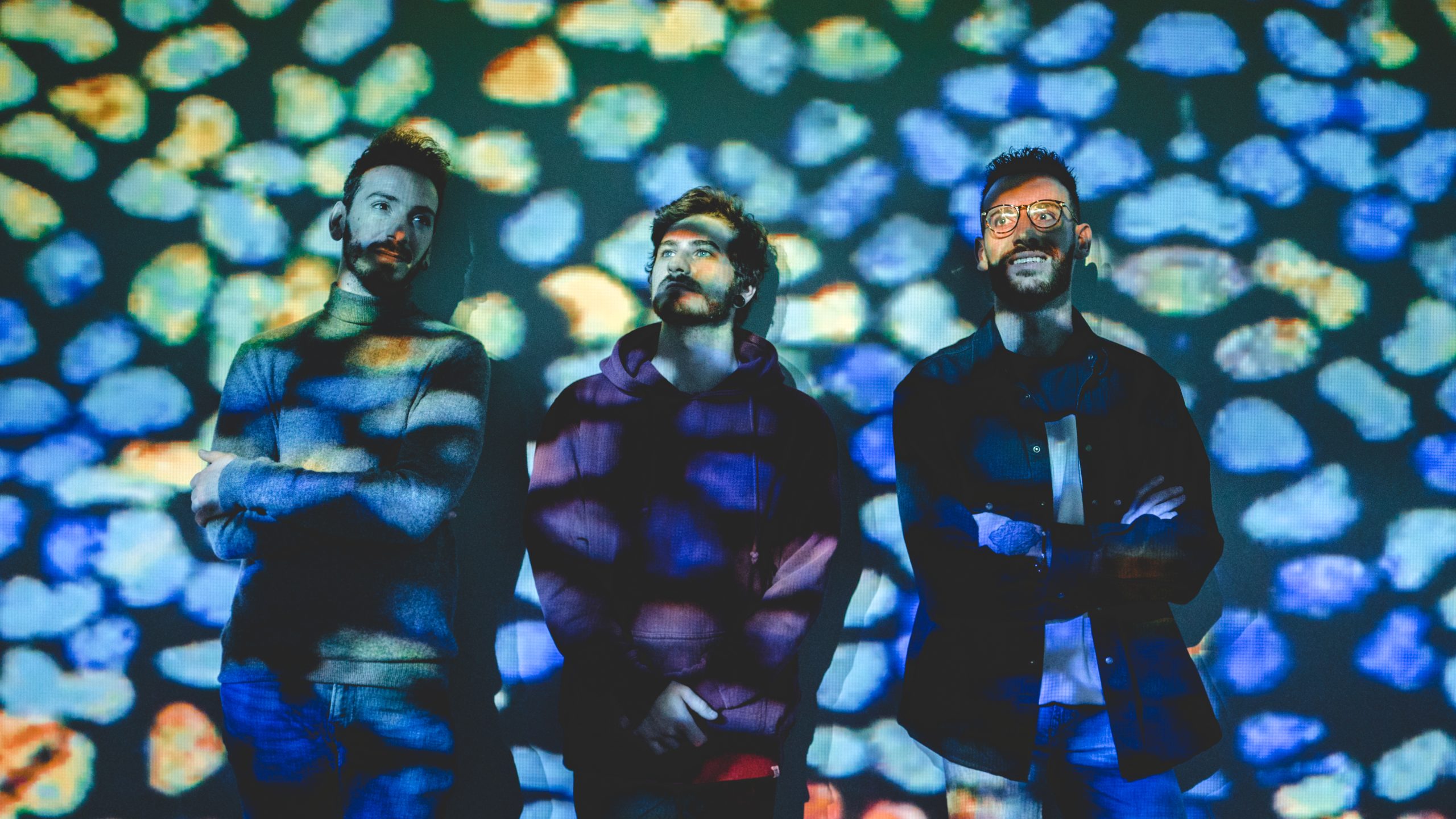
Do you think your background as scientists is important for making you good science communicators?
Renaud – We don’t believe you have to be a scientist to do good science communication. But the good thing about being a former researcher is that we know about the everyday life of the scientists; that they often lack the time and the money to be able to share their research with the public. For Cell Worlds, since we both come from a microscopy background, we knew that scientists had gigabytes of images that were never going to leave the lab. But they have stories and they are beautiful. Because we knew this, we thought that others probably shared our frustration that these images were not being used. Between us, we realised we had a list of inspiring scientists that were already sharing their images on Twitter. When we contacted them, they all just said ‘yes, just do it, you can use our images’.
Terence – I think we are lucky to have this understanding of the lab, but we really think you can speak about science without having a big scientific background. That’s part of the story of Cell Worlds, anyone can understand and participate in science. It is truly open science and this is an important part of our mission.
Aside from the microscopy images, where did the inspiration for Cell Worlds come from?
Renaud – There are many inspirations for Cell Worlds. One thing we were clear about from the start was that we wanted to create a narration that is quite different from classical documentaries. We realised that we share a big passion for music, and we have similar tastes, for example we love electronic music, but also orchestral music, which can bring a different power to the soundtrack. This was the inspiration to pick one musician to become part of our team of three, all with complimentary skills.
Terence – Yes, the music is definitely very cool! We also recognised the role of the internet culture in connecting with the public, especially younger people. The internet has made the way that people get news and access information very different from in the past, especially with social media. For us to have a documentary was very cool, but it was important that we shared it on YouTube, where it is totally free and very easy to share on social media platforms such as Twitter.
Renaud – It brings us back to our open science goals. We produced something that is available to people for free; they can play it on YouTube, or project it somewhere. We think that it is important to make these stories accessible for the public.
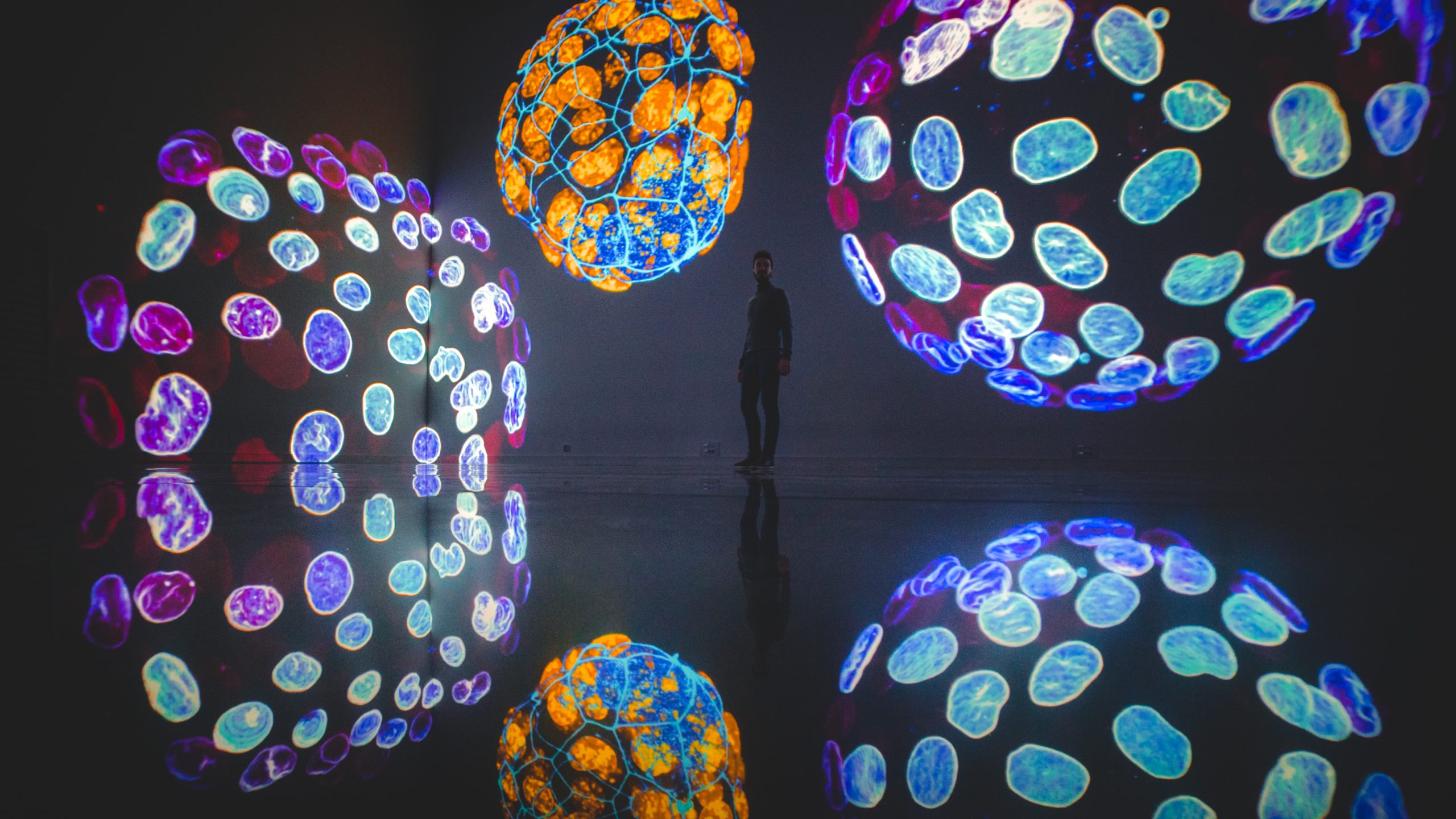
One thing that struck me about the documentary was that it appealed to such a broad range of people. For example, scientists really love it, perhaps for the images and the music more than the story, whereas children want to hear/see the story as well as the dramatic images and music. Was that broad audience appeal something you were aiming for?
Terence – It’s funny, we found that the documentary took the scientists back to when they started working in science. They told us that it reminded them of why they love science and why they became biologists!
Renaud – We built the documentary to target the same audience as Terence’s YouTube channel, … as that is where we published it. So, we were aiming to connect with teenagers and young adults. But we didn’t really anticipate that younger children would be watching it, but it was amazing, and we realised that our storytelling worked for them as well. We also received messages from teachers asking us about using the documentary to introduce a lesson or showing it to their classes. Another good thing was that scientists became great ambassadors for the documentary, as they were sharing it everywhere! We were so happy to see this collective effort to disseminate it.
Can you tell us more about the exhibition?
Terence – our idea was the exhibition should be an immersive experience. We wanted the audience to be surrounded by the microscopy. The images are projected on all four walls and the floor is a mirror, so you see the reflections from the walls. Of course, it is impossible to be immersed in this world in our reality, so the exhibition creates a dream world for the scientists, the school children, and the public in general.
Renaud – We have a fun story about the exhibition to share with you. We had a small launch, helped by the CNRS, the national institute of research in France. The cool story was seeing some very senior scientists behaving like 5 year olds! Running around searching for their images and even dancing along with them! That was so cool to see, the happiness in that room!
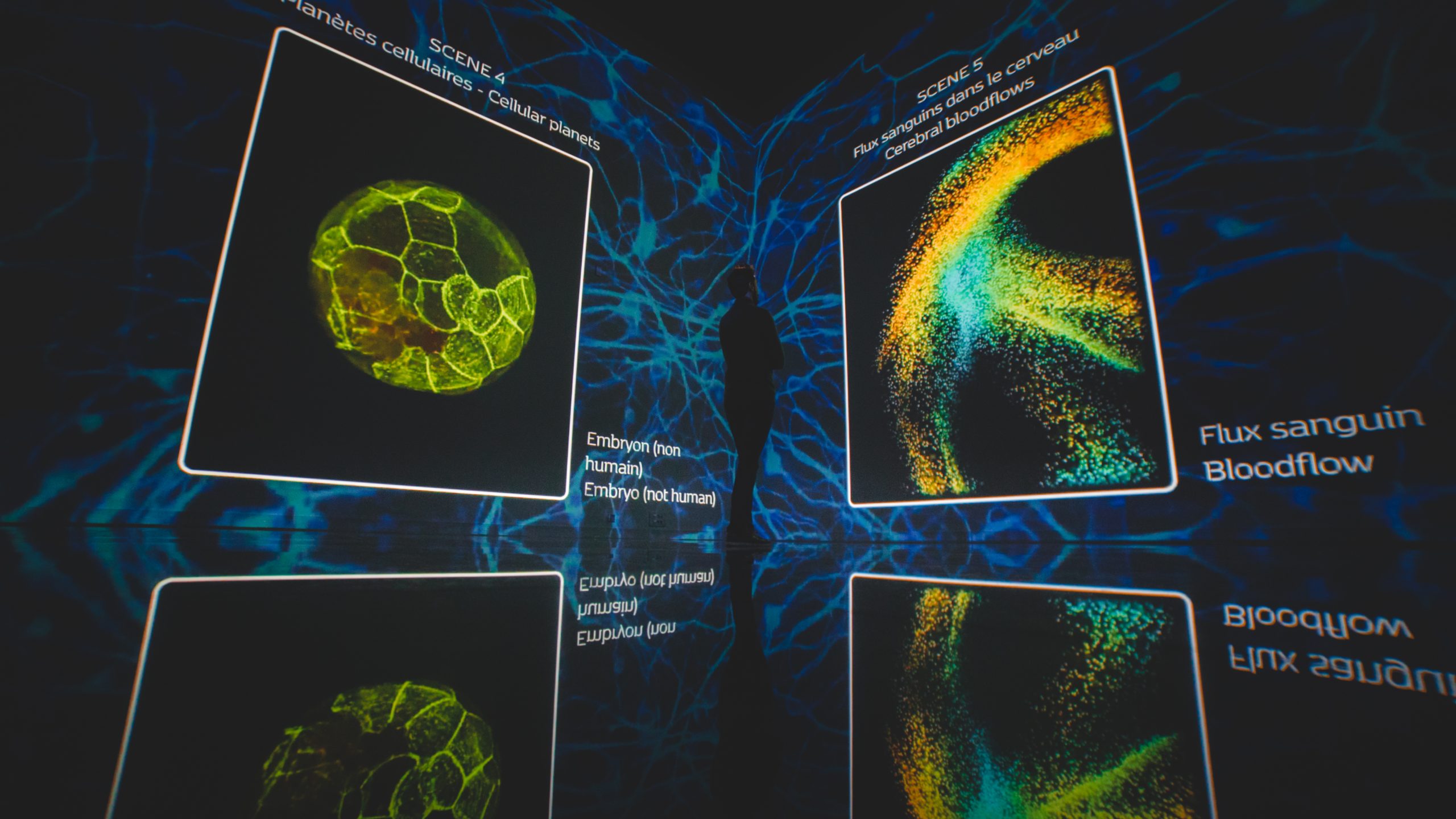
Does the exhibition tell the same story as the documentary?
Terence – It is quite different, but the aims are the same. With the exhibition, the idea is to use the entertainment to give the message to the public. But it’s more than just entertainment, we use the beautiful music and images to raise awareness of the science. Only at the end of the exhibition, do you discover what you have been looking at. We write on the wall ‘this is a neuron’ or ‘this is an embryo’, so people now connect that the images they are seeing are actually cells inside them. The museum hosting the exhibition has never hosted any science before, so it was exciting to bring together the art and science worlds.
Can you share the ‘vital statistics’ of the documentary and exhibition?
Renaud – Our nuclear team is three, me, Terence and Youenn, who composed the music. The music is particularly important in the exhibition as there is no voiceover. This means the narrative comes from the music. For the documentary, we also had two actresses helping us with the voiceover. They coached us to use our voices for the audio, as well as adding their own voices. They also tested the script and helped us add an artistic layer to the words. Then we have all the scientists that contributed images. It’s an international team, although initially many of the team were French, with collaborations with some of the top institutes in France. We then had scientists from other institutes join the team; you can see the full list on our website.
In terms of the documentary, we have reached 14,000 views (May 2022). That happened quite quickly! We are continuing to promote the documentary, for example we will share it in a cinema soon. We are also trying to push it to festivals, to really bring it to new audiences, in new places. We really want to get those images to the public, far from the lab.
We think that our exhibition is the first project, at least on this kind of scale (including so many teams, and also in terms of the physical size of the exhibition) to bring biology to the general public in this format. That’s why we called it a world premiere! So, we wanted to know if the people attending the exhibition are seeing a science and art show for the first time. We could collect this information at the end of the exhibitions via our website, which helps connects the exhibition with the documentary. The audience scan a QR code and are taken to a survey asking them if this is their first experience of an art and science show. So far, it is about 85%. We also ask whether people are interested in learning more about the microscopic world. This is about 75%. We think these numbers mean that we are achieving our goal, to get a new audience to engage with science. We chose the art centre because we knew that their main audience are not scientists.
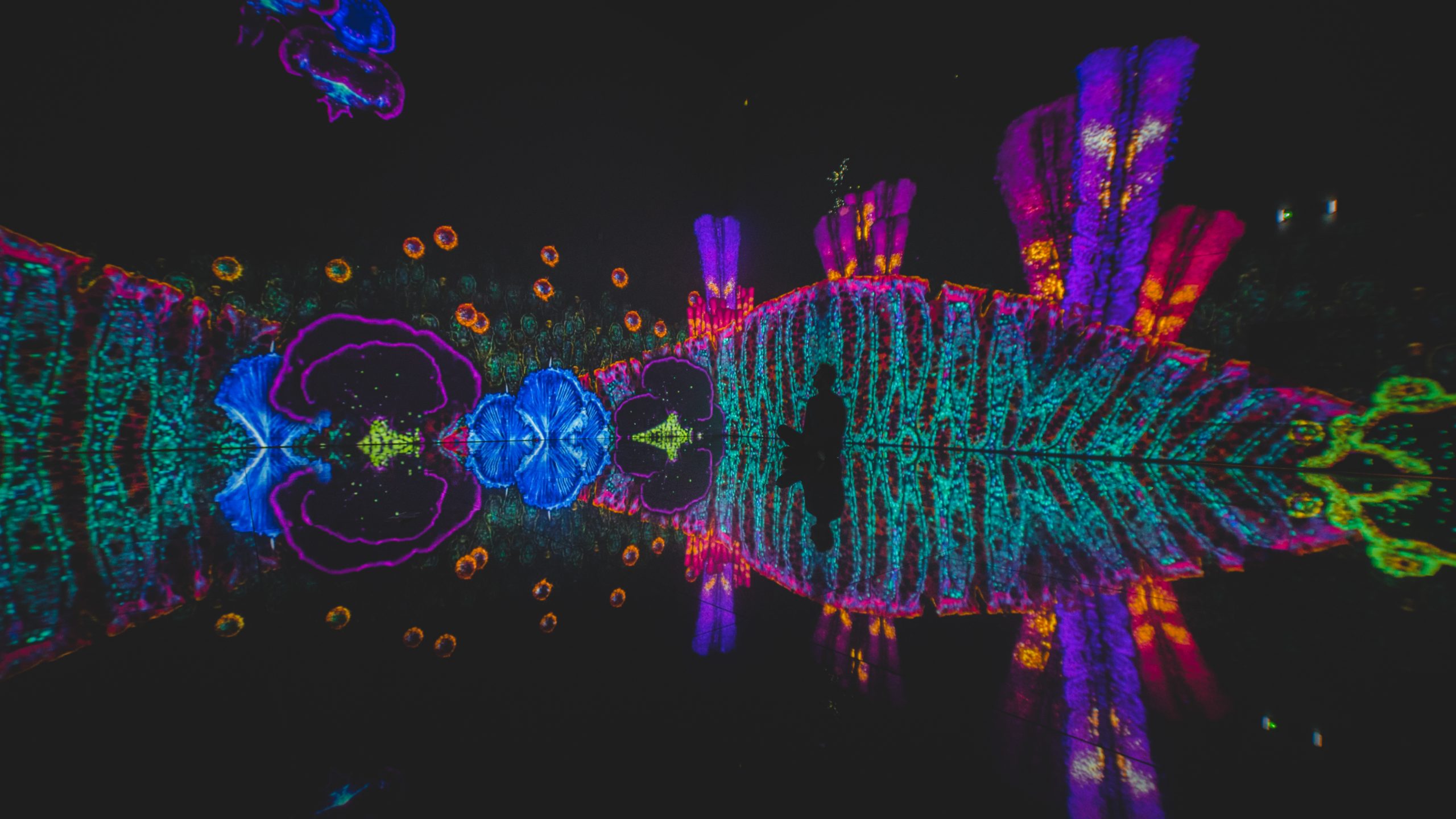
How did you select the scientists that became part of the project?
Both – We only had one condition, a willingness to share their images! And all the scientists that we approached were already sharing their research on social media. Often, we only ‘knew’ the researchers because we followed them on Twitter. We just approached people with images that we liked. And we also had recommendations from other scientists either because they had seen some great images, or they were suggesting a new topic for us to cover.
So, which came first the images or the story?
Renaud – It was a little of both! We knew there were some topics that we wanted to cover, and then we looked around to see if there was someone we could connect with on that area. But we also introduced some topics because of the images we had seen. It didn’t matter if we knew that subject, we were interested in sharing the message of the researcher and they know the story, so we just had to look for cool stuff to share!
Terence – So, Cell Worlds is like the theory of evolution; not to have a set plan at the start but the project is made of many different blocks that build the wall.
Where did you get funding?
Terence – The funding came from two sources. Half from the museum that is hosting the exhibition in Bassins des Lumiéres, Bordeaux. And the other half is from le Centre national du cinéma in France, which helped us make the documentary. It was enough to cover our project. We were lucky as getting funding for science popularisation can be complicated.
Renaud – The funding from the le Centre national du cinéma was a competitive process. They were looking for different types of projects in arts and culture. We made an application, trying to be as clear as possible about our vision. They liked the project and decided to support us.
Why both an exhibition and documentary?
Terence – We really think about Cell Worlds as only one project. The images are the same and much of the music is the same. But we can give you a bit of history as to how it came together.
Renaud – When we started thinking about making the documentary, we really wanted it to be an immersive experience. Actually ‘immersive’ is not quite the right word but we wanted the viewer to feel that they were projected into an ecosystem, seeing it like a jungle with all its wildlife. The microscopic world is like another ecosystem, and we help the audience to enter with the voiceover. Whilst working on the project, we were in the museum, and we thought ‘how cool would it be to have a cell that is higher than you’. So, we contacted the museum about using the space. We quickly realised that the exhibition and the documentary would be complimentary – you can enjoy either without seeing the other – but we wanted to build our audiences’ desire to see both. Whilst the images and much of the music are the same, the narrative is different because of the different ways you engage with them. For example, at the exhibition you are more on your own, and if you see if a second time you don’t see it in the same way, because you already have the answers that appear at the end of the show. The voiceover in the documentary gives you more new information. We think that having these different outputs means we can reach a broader audience, and this is one of the main aims of the project. The link between the two is the website, but this is really just to direct people to the output that they have not already seen.
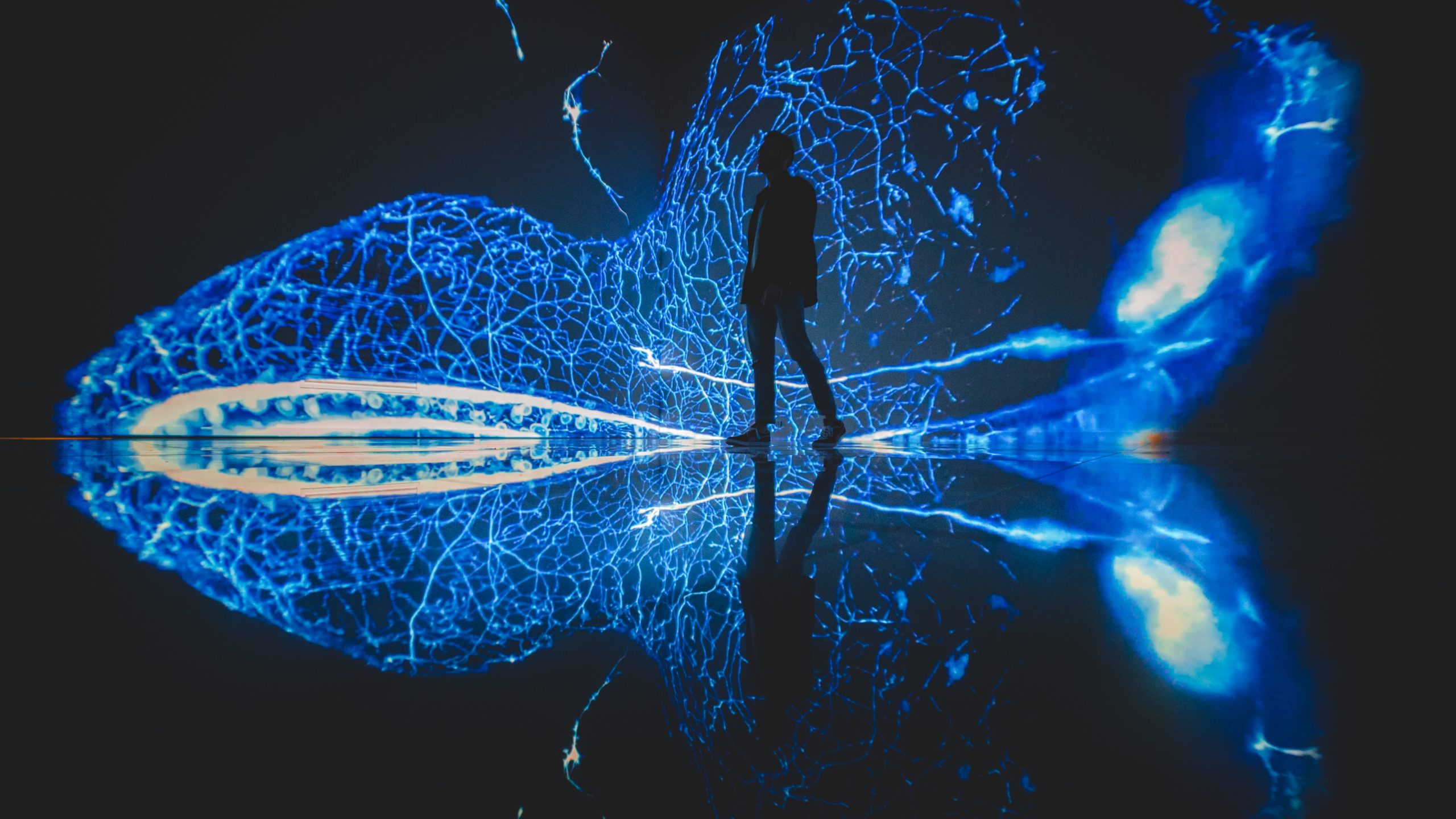
What are you working on next, as a team or individuals?
Both – We want to do many things!
Terence – We want to continue to work on open science with our incubator L’Exploratoire. Cell Worlds is a part of this incubator, but we want to continue our mission to explain science to the public in new ways. Not, of course, the academic way of explaining science but allowing the citizens to be actors in science, to participate. This is not really one project but more of an ambition for what we are doing in our other projects. Renaud, maybe you can speak about our new project, ‘Méandres’, ‘Meander’ in English.
Renaud – So, Méandres is about everything being connected or aligned. The project is centred in the notion of open science. We want to connect citizens with science in ways that are not ‘boring’ and allow them to experience science rather than just receiving the information. Méandres has the same team as Cell Worlds. We wanted to keep the same team; we work well together covering science popularisation, culture and music. It just makes sense! We will be working on a completely different project and it is more based on Terence and Youenn’s expertise. It is about how we can talk about neuroscience, emotions and human neurological mechanism through reactions to lost architecture and buildings. In France, we have a lot of heritage buildings, which have fantastic stories and interesting histories. We want to use exploration of abandoned heritage to help talk about neuroscience. Putting people in unknown places raises emotions, so we can see the response and then explain it together. Urban exploration can look spectacular, with many images on the internet, but for us it is really a way to talk about social science and neuroscience. So, the idea is that we will take someone who is not use to those places, we will go with this person to visit an unknown place and observe both the place and the person’s reaction to it, their emotions. There are common emotional reactions to unknown places, especially in terms of fear responses. We would like to demystify the link between the emotions they have experienced, and the neurological mechanisms involved. So, we are talking about neuroscience as part of a shared experience. We will also have the opportunity to talk about these abandoned buildings and their past functions in society, meaning that we can preserve the memories of these places. We already have some locations in mind and we have the people to produce the first episode of the series. Then we will take different people to different places, to cover new topics.
Thanks to Terence and Renaud to talking to us about the fabulous Cell Worlds project as well as giving us a sneak-peek at their new project. We look forward to seeing more of your work in the future.


 (No Ratings Yet)
(No Ratings Yet)